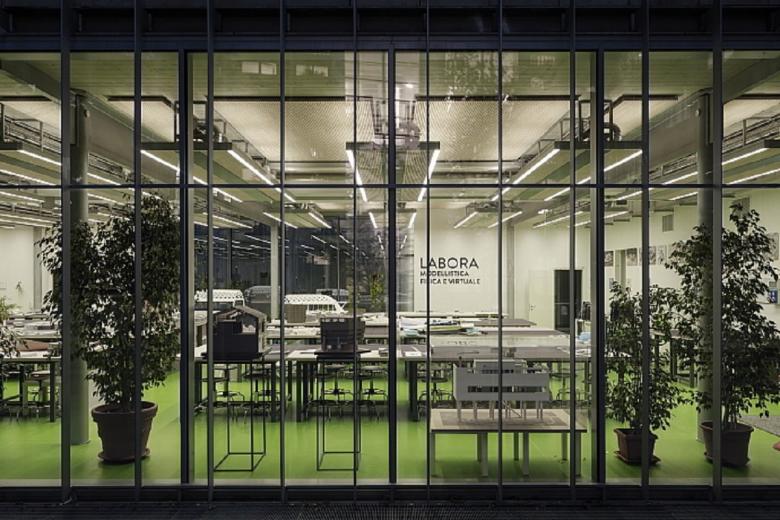Architecture Campus of Politecnico in Milano
Milano, Italy

Chilled ceiling panel INDUCOOL in the Architecture Campus, Politecnico in Milano.
Efficiency and comfortable climate in an Italian university.
How will climate systems be used in educational institutions during and after the Corona pandemic? The completely redesigned Architecture Campus of the Politecnico di Milano in Italy could provide an answer. In addition to improving the quality and functionality of the buildings and enhancing the entire area with green spaces, innovative solutions were used for air-conditioning: chilled ceiling panels from Kiefer Klimatechnik not only offer efficiency and optimal conditions for thermal and acoustic comfort, but also guarantee the best hygienic indoor air quality.
The Architecture Campus of the Politecnico di Milano was born thanks to an idea by Renzo Piano donated to the Politecnico and developed by the ODB-OTTAVIO DI BLASI & Partners studio to rethink the spaces in via Bonardi, adapting them to the needs of students and to the open, international and innovative approach that distinguishes the Politecnico. An intervention that saw the construction of 4,200 square meters of new buildings which, starting below the street level, rise up to 3 floors above ground, hosting the Aula Magna, multifunctional classrooms, rooms for teaching and Architecture’s laboratories. The outdoor campus area was upgraded with new trees and green spaces.
Open ceilings with deliberately visible technical construction
For excellent climatic conditions in the interior spaces, the architects relied on a combination of complex solutions: To reduce the energy demand in total, a façade with selective glass, a low heat transfer coefficient and with a low solar factor was installed. Vertical louvres and additional blinds inside control the cooling load. The rooms were each equipped with INDUCOOL high-performance cooling ceiling panels from Kiefer Klimatechnik in Stuttgart. Cooling is achieved simultaneously via air and water. Integrated slot diffusers distribute the supply air into the rooms without draughts - an enormous advantage over air-conditioning systems, which often cause unpleasant draughts. The Politecnico in Milano opted for this system, partly because the use of free cooling with outside air reduces operating costs to a minimum. The way it works is simple and intelligent: the integrated slot diffuser draws the warm room air over the water-cooled aluminium ribbed plates through its induction effect. Depending on the dimensioning, a cooling capacity of up to 500 W/m can be achieved. For this reason, it is sufficient to cover only five to ten per cent of the ceiling surfaces with INDUCOOL panels. The rest of the ceiling is available to the architects for free design. In this case, the planners opted for a partially suspended ceiling installation: the cooling panels are integrated into a multifunctional structure consisting of wooden side walls with an acoustic function and LED light strips on both sides. In between, all installations were deliberately left visible: Ducts, pipes, electrical wiring, lighting and other exposed installations are intended to create a highly technical overall impression. This fits perfectly into the context of the academic institution, which is dedicated to the teaching of technical disciplines. In addition, it is intended to serve a didactic function: It gives students the opportunity to appreciate and understand the importance of technology in the service of architecture.
Well-being and indoor air quality for a perfect hygienic indoor climate
In order to counteract the spread of viruses and bacteria in the classrooms, the points of hygiene and cleaning played an important role in the selection of the air conditioning and ventilation technology. With the INDUCOOL system, heat exchange takes place directly at the ribbed plates on the underside of the panel. In contrast to classic chilled beams, the room air does not flow through the false ceiling space or into the plenum box. This means that there is no contamination or accumulation of viruses here. The low supply air temperature and the associated dehumidification of the supply air also reliably prevents condensation. Resulting hygienic problems, such as germ formation, can therefore be ruled out. In addition to these perfect hygienic conditions, the INDUCOOL system also offers a very high level of comfort: the conditioned supply air is introduced into the room through fine nozzles and divided into numerous individual jets. Due to the high induction, it mixes quickly with the room air and thus ensures the best possible distribution in the room. This mixed air is introduced into the occupied zone at very low velocities, thus avoiding user complaints due to draughts. The Stuttgart air-conditioning experts achieve a maximum satisfaction rate of 95 per cent with their chilled ceiling panel.



- Manufacturers
- Kiefer Klimatechnik GmbH
- Location
- Piazza Leonardo da Vinci, 32, 20133 Milano, Italy
- Year
- 2021
- Client
- Politecnico di Milano Italy
- Team
- Ing. Luca Stefanutti TEKNE Milano Italy, arch. Ottavio di Blasi ODB & Partners Milano Italy (idea and participation of Renzo Piano)






